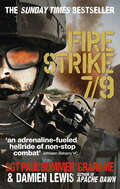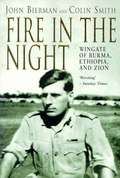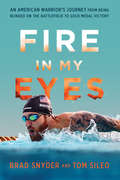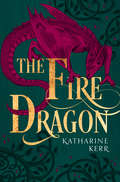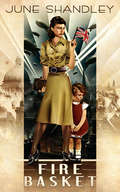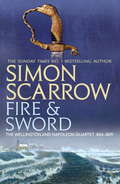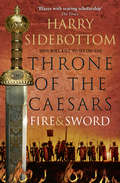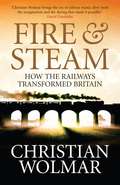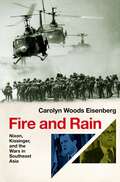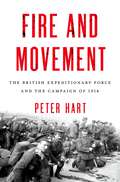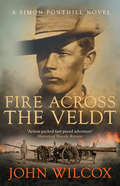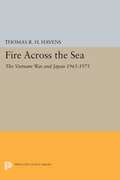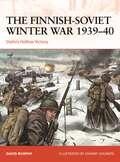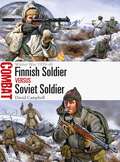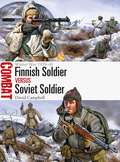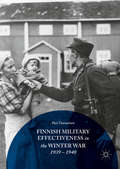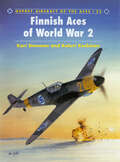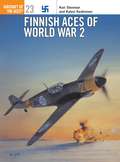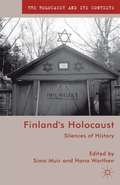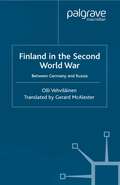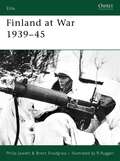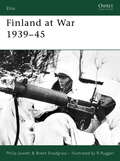- Table View
- List View
Fire Strike 7/9
by Damien Lewis Paul Grahame'Being a JTAC is the closest a soldier on the ground in the midst of battle can get to feeling like one of the gods - unleashing pure hellfire, death and destruction' - Duncan FalconerMeet Sergeant 'Bommer' Grahame, one of the deadliest soldiers on the battlefield. He's an elite army JTAC (Joint Terminal Attack Controller- pronounced 'jay-tack') - a specially trained warrior responsible for directing Allied air power with high-tech precision. Commanding Apache gunships, A10 tank-busters, F15s and Harrier jets, he brings down devastating fire strikes against the attacking Taliban, often danger close to his own side. Due to his specialist role, Sergeant Grahame usually operates in the thick of the action, where it's at its most fearsome and deadly. Conjuring the seemingly impossible from apparently hopeless situations, soldiers in battle rely on the skill and bravery of their JTAC to enable them to win through in the heat of the danger zone. Fire Strike 7/9 tells the story of Bommer Grahame and his five-man Fire Support Team on their tour of Afghanistan. Patrolling deep into enemy territory, they were hunted and targeted by the Taliban, shot at, blown-up, mortared and hit by rockets on numerous occasions. Under these conditions Sergeant Grahame notched up 203 confirmed enemy kills, making him the difference between life and death both for his own troops and the Taliban.
Fire in the Night: Wingate of Burma, Ethiopia and Zion
by C Smith J BiermanOrde Charles Wingate. Winston Churchill thought him a military genius; others considered him greatly over-rated; a few even thought him mad. His overriding passion was for Zionism, a cause which he embraced when posted to British-ruled Palestine in 1936. There he raised the Special Night Squads, an irregular force which decimated Arab rebel bands and taught a future generation of Israeli generals (including Moshe Dayan and Yitzhak Rabin) how to fight. In 1941, Wingate led another guerrilla-style force into Italian-occupied Ethiopia and was instrumental in restoring Emperor Haile Selassie to his throne. But his most famous campaign was conducted behind enemy lines in Burma, where his Chindits shattered the myth of Japanese invincibility in jungle fighting. A brilliant maverick, Wingate was a difficult if not impossible subordinate. He was also - as this riveting new study reveals - an inspiring leader.
Fire in My Eyes: An American Warrior's Journey from Being Blinded on the Battlefield to Gold Medal Victory
by Brad Snyder Tom Sileo"I am not going to let my blindness build a brick wall around me. I'd give my eyes one hundred times again to have the chance to do what I have done, and what I can still do."-Brad Snyder speaking with First Lady Michelle ObamaOn the night Osama bin Laden was killed, US Navy Lieutenant Brad Snyder was serving in Afghanistan as an Explosive Ordnance Disposal officer with SEAL Team Ten. When he learned of SEAL Team Six's heroics across the Pakistani border, Brad was thankful. Still, he knew that his dangerous combat deployment would continue.Less than five months later, Brad was engulfed by darkness after a massive blast caused by an enemy improvised explosive device. Suddenly Brad was blind, with vivid dreams serving as painful nightly reminders of his sacrifice.Exactly one year after losing his sight, Brad heard thousands cheer as he stood on a podium in London. Incredibly, Brad had just won a gold medal in swimming at the 2012 Paralympic Games.Fire in My Eyes is the astonishing true story of a wounded veteran who refused to give up. Lieutenant Brad Snyder did not let blindness build a wall around him-through tenacity and courage, he tore it down.
The Fire Dragon (The Dragon Mage #3)
by Katharine KerrBook eleven of the celebrated Deverry series, an epic fantasy rooted in Celtic mythology that intricately interweaves human and elven history over several hundred years.
Fire Basket
by June ShandleyIn the years between the wars, Edith May Faulks from the Rhondda Valley in Wales goes into service in the London home of Lord and Lady Havis, leaving behind her brothers and sisters and her old way of life. There she meets and falls in love with Peter. But he is sent away to New York, where he mysteriously disappears and Edith is forced to move on. Eventually marrying and settling on the Dorset coast, Edith has to raise her children on her own while her husband, Leslie, is away at war, and their lives are played out against a backdrop of air raids, ration books and shortages of food and clothing. Despite all their privations and difficulties, they get by. But the return of a ghost from Edith's past threatens to disrupt the life she has tried so hard to provide for herself and her family...
Fire and Sword: (Revolution 3) (The Wellington and Napoleon Quartet)
by Simon ScarrowFIRE AND SWORD is the unputdownable third novel in Simon Scarrow's bestselling Wellington and Napoleon Quartet. A must read for fans of Robert Harris.1804. Napoleon Bonaparte is Emperor of France, his ultimate aim: to rule Europe. After defeat at the Battle of Trafalgar, he wins a glorious victory against Austria at Austerlitz. He then deposes the Spanish king and places his own brother on the throne. But he is yet to triumph over his most hated enemy: Great Britain.Arthur Wellesley (the future Duke of Wellington) throws himself into the British campaign in Europe. After glory in Portugal, he commands the army in a series of triumphant battles across Spain. For those living reluctantly under French rule, his victories suggest that Napoleon's progress is not inexorable: freedom can be restored...
Fire and Sword: Throne Of Caesars: Book Three (Throne of the Caesars #3)
by Harry Sidebottom‘Absorbing and brilliant … Game of Thrones without the dragons’ THE TIMES The third book in Sidebottom’s epic series set in third century Rome; a dramatic era of murder, coup, counter-rebellions and civil war.
Fire and Steam: A New History of the Railways in Britain
by Christian WolmarThe opening of the pioneering Liverpool and Manchester Railway in 1830 marked the beginning of the railways' vital role in changing the face of Britain. Fire and Steam celebrates the vision and determination of the ambitious Victorian pioneers who developed this revolutionary transport system and the navvies who cut through the land to enable a country-wide network to emerge. From the early days of steam to electrification, via the railways' magnificent contribution in two world wars, the chequered history of British Rail, and the buoyant future of the train, Fire and Steam examines the social and economical importance of the railway and how it helped to form the Britain of today.
Fire and Rain: Nixon, Kissinger, and the Wars in Southeast Asia
by Carolyn Woods EisenbergThis gripping account interweaves Nixon and Kissinger's pursuit of the war in Southeast Asia and their diplomacy with the Soviet Union and China with on-the-ground military events and US domestic reactions to the war conducted in Vietnam, Laos, and Cambodia. Fire and Rain is a compelling, meticulous narrative of the way national security decisions formed at the highest levels of government affect the lives of individuals at home and abroad. By drawing these connections, Carolyn Woods Eisenberg brings to life policy decisions about Vietnam, Laos, and Cambodia, conveying their significance to a new generation of readers. She breaks fresh ground in contextualizing Richard Nixon and Henry Kissinger's decisions within a wider institutional and societal framework. While recognizing the distinctive personalities and ideas of these two men, this study more broadly conveys the competing roles and impact of the professional military, the Congress, and a mobilized peace movement. Drawing upon a vast collection of declassified documents, Eisenberg presents an important re-interpretation of the Nixon Administration's relations with the Soviet Union and China vis a vis the war in Southeast Asia. She argues that in their desperate effort to overcome, or at least overshadow, their failure in Vietnam, Nixon and Kissinger made major concessions to both nations in the field of arms control, their response to the India-Pakistan war, and the diplomacy surrounding Taiwan--much of this secret. Despite policymakers' claims that the Vietnam War was a "national security" necessity that would demonstrate American strength to the communist superpowers and "credibility" to friendly governments, the historical record suggests a different reality. A half-century after the Paris Peace Conference marking the withdrawal of US troops and advisors from Vietnam and foreign troops from Laos and Cambodia, Fire and Rain is a dramatic account of geopolitical decision making, civil society, and the human toll of the war on the people of Southeast Asia.
Fire and Rain: Nixon, Kissinger, and the Wars in Southeast Asia
by Carolyn Woods EisenbergThis gripping account interweaves Nixon and Kissinger's pursuit of the war in Southeast Asia and their diplomacy with the Soviet Union and China with on-the-ground military events and US domestic reactions to the war conducted in Vietnam, Laos, and Cambodia. Fire and Rain is a compelling, meticulous narrative of the way national security decisions formed at the highest levels of government affect the lives of individuals at home and abroad. By drawing these connections, Carolyn Woods Eisenberg brings to life policy decisions about Vietnam, Laos, and Cambodia, conveying their significance to a new generation of readers. She breaks fresh ground in contextualizing Richard Nixon and Henry Kissinger's decisions within a wider institutional and societal framework. While recognizing the distinctive personalities and ideas of these two men, this study more broadly conveys the competing roles and impact of the professional military, the Congress, and a mobilized peace movement. Drawing upon a vast collection of declassified documents, Eisenberg presents an important re-interpretation of the Nixon Administration's relations with the Soviet Union and China vis a vis the war in Southeast Asia. She argues that in their desperate effort to overcome, or at least overshadow, their failure in Vietnam, Nixon and Kissinger made major concessions to both nations in the field of arms control, their response to the India-Pakistan war, and the diplomacy surrounding Taiwan--much of this secret. Despite policymakers' claims that the Vietnam War was a "national security" necessity that would demonstrate American strength to the communist superpowers and "credibility" to friendly governments, the historical record suggests a different reality. A half-century after the Paris Peace Conference marking the withdrawal of US troops and advisors from Vietnam and foreign troops from Laos and Cambodia, Fire and Rain is a dramatic account of geopolitical decision making, civil society, and the human toll of the war on the people of Southeast Asia.
Fire and Movement: The British Expeditionary Force and the Campaign of 1914
by Peter HartThe dramatic opening weeks of the Great War passed into legend long before the conflict ended. The British Expeditionary Force fought a mesmerizing campaign, outnumbered and outflanked but courageous and skillful, holding the line against impossible odds, sacrificing themselves to stop the last great German offensive of 1914. A remarkable story of high hopes and crushing disappointment, the campaign contains moments of sheer horror and nerve-shattering excitement; pathos and comic relief; occasional cowardice and much selfless courage--all culminating in the climax of the First Battle of Ypres. And yet, as Peter Hart shows in this gripping and revisionary look at the war's first year, for too long the British part in the 1914 campaigns has been veiled in layers of self-congratulatory myth: a tale of poor unprepared Britain, reliant on the peerless class of her regular soldiers to bolster the rabble of the unreliable French Army and defeat the teeming hordes of German troops. But the reality of those early months is in fact far more complex--and ultimately, Hart argues, far more powerful than the standard triumphalist narrative. Fire and Movement places the British role in 1914 into a proper historical context, incorporating the personal experiences of the men who were present on the front lines. The British regulars were indeed skillful soldiers, but as Hart reveals, they also lacked practice in many of the required disciplines of modern warfare, and the inexperience of officers led to severe mistakes. Hart also provides a more accurate portrait of the German Army they faced--not the caricature of hordes of automatons, but the reality of a well-trained and superlatively equipped force that outfought the BEF in the early battles--and allows readers to come to a full appreciation of the role of the French Army, without whom the Marne never would have been won. Ultimately Fire and Movement shows the story of the 1914 campaigns to be an epic tale, and one which needs no embellishment. Through the voices and recollections of the soldiers who were there, Hart strips away the myth to offer a clear-eyed account of the remarkable early days of the Great War.
Fire and Movement: The British Expeditionary Force and the Campaign of 1914
by Peter HartThe dramatic opening weeks of the Great War passed into legend long before the conflict ended. The British Expeditionary Force fought a mesmerizing campaign, outnumbered and outflanked but courageous and skillful, holding the line against impossible odds, sacrificing themselves to stop the last great German offensive of 1914. A remarkable story of high hopes and crushing disappointment, the campaign contains moments of sheer horror and nerve-shattering excitement; pathos and comic relief; occasional cowardice and much selfless courage--all culminating in the climax of the First Battle of Ypres. And yet, as Peter Hart shows in this gripping and revisionary look at the war's first year, for too long the British part in the 1914 campaigns has been veiled in layers of self-congratulatory myth: a tale of poor unprepared Britain, reliant on the peerless class of her regular soldiers to bolster the rabble of the unreliable French Army and defeat the teeming hordes of German troops. But the reality of those early months is in fact far more complex--and ultimately, Hart argues, far more powerful than the standard triumphalist narrative. Fire and Movement places the British role in 1914 into a proper historical context, incorporating the personal experiences of the men who were present on the front lines. The British regulars were indeed skillful soldiers, but as Hart reveals, they also lacked practice in many of the required disciplines of modern warfare, and the inexperience of officers led to severe mistakes. Hart also provides a more accurate portrait of the German Army they faced--not the caricature of hordes of automatons, but the reality of a well-trained and superlatively equipped force that outfought the BEF in the early battles--and allows readers to come to a full appreciation of the role of the French Army, without whom the Marne never would have been won. Ultimately Fire and Movement shows the story of the 1914 campaigns to be an epic tale, and one which needs no embellishment. Through the voices and recollections of the soldiers who were there, Hart strips away the myth to offer a clear-eyed account of the remarkable early days of the Great War.
Fire Across the Veldt (Simon Fonthill #9)
by John WilcoxSouth Africa, 1900. The bloody conflict between the forces of the British Empire and the Boer farmers seemed at last to have ended in victory for Queen Victoria’s soldiers, with the Boer capitals taken and occupied. But fast-riding Boer commandos have emerged to introduce a new type of warfare – hit-and-run guerrilla tactics, fought across the veldt of South Africa and leaving the British ‘Khakis’ plodding and bruised in their wake.To counter these strikes, the British General Kitchener persuades Simon Fonthill, fresh from his triumphs in China’s Boxer Rebellion, to divert to Cape Town and fight the Boers at their own game. So Fonthill, with his old comrade 352 Jenkins as his Regimental Sergeant Major, finds himself reinstated in the British Army as the colonel of his own cavalry unit.Can the two of them adapt to regular soldiering again – and will they be able to catch and pin down those elusive Boer Generals, Louis Botha and Christiaan de Wet? And can Simon’s wife, Alice, reporting on the war for the MorningPost, extricate herself from her own problems in South Africa?
Fire Across the Sea: The Vietnam War and Japan 1965-1975
by Thomas R.H. HavensProfessor Havens analyzes the efforts of Japanese antiwar organizations to portray the war as much more than a fire across the sea" and to create new forms of activism in a country where individuals have traditionally left public issues to the authorities. This path-breaking study examines not only the methods of the protesters but the tightrope dance performed by Japanese officials forced to balance outspoken antiwar sentiment with treaty obligations to the U.S.Originally published in 1987.The Princeton Legacy Library uses the latest print-on-demand technology to again make available previously out-of-print books from the distinguished backlist of Princeton University Press. These editions preserve the original texts of these important books while presenting them in durable paperback and hardcover editions. The goal of the Princeton Legacy Library is to vastly increase access to the rich scholarly heritage found in the thousands of books published by Princeton University Press since its founding in 1905.
The Finnish-Soviet Winter War 1939–40: Stalin's Hollow Victory (Campaign)
by David MurphyThis informative study explores the Soviet invasion of Finland, detailing the events of the Winter War of November 1939 to March 1940. The invasion was expected to be swift and decisive, however, the fighting qualities of the Finnish Army blunted the Soviet advance and inflicted high numbers of casualties. A combination of difficulties caused by the weather, the terrain, the Mannerheim Line defences and Finnish tactics resulted in a fascinating David vs Goliath type struggle.On 23 August 1939, a secret protocol was appended to the German–Soviet Non-Aggression Pact; as part of this, Finland was assigned to the Soviet sphere of influence. On 30 November that year, in an effort to protect against renewed German aggression in the East, the Soviet Union attacked Finland, beginning what became known as the Finnish-Soviet Winter War. This long-awaited addition to the Campaign series explores the events of the war of November 1939 to March 1940. Set against the background of the developing global conflict, the conflict saw the Finnish Army thwart the plans of the sizeable Soviet forces assembled against it, before finally being forced to concede. The major battles of the war, which took place in harsh winter conditions, are covered in detail, including the Mannerheim Line, the fighting in Ladoga Karelia and Kollaa, and the clashes in Finnish Lapland.
The Finnish-Soviet Winter War 1939–40: Stalin's Hollow Victory (Campaign #367)
by David MurphyThis informative study explores the Soviet invasion of Finland, detailing the events of the Winter War of November 1939 to March 1940. The invasion was expected to be swift and decisive, however, the fighting qualities of the Finnish Army blunted the Soviet advance and inflicted high numbers of casualties. A combination of difficulties caused by the weather, the terrain, the Mannerheim Line defences and Finnish tactics resulted in a fascinating David vs Goliath type struggle.On 23 August 1939, a secret protocol was appended to the German–Soviet Non-Aggression Pact; as part of this, Finland was assigned to the Soviet sphere of influence. On 30 November that year, in an effort to protect against renewed German aggression in the East, the Soviet Union attacked Finland, beginning what became known as the Finnish-Soviet Winter War. This long-awaited addition to the Campaign series explores the events of the war of November 1939 to March 1940. Set against the background of the developing global conflict, the conflict saw the Finnish Army thwart the plans of the sizeable Soviet forces assembled against it, before finally being forced to concede. The major battles of the war, which took place in harsh winter conditions, are covered in detail, including the Mannerheim Line, the fighting in Ladoga Karelia and Kollaa, and the clashes in Finnish Lapland.
Finnish Soldier vs Soviet Soldier: Winter War 1939–40 (Combat #21)
by David CampbellThe Winter War was supposed to be a quick and easy conflict; instead it proved to be a bitter war that destroyed the international reputation of the Soviet Red Army. The diminutive Finnish force was desperately outnumbered by almost half a million Russian troops, but rather than sweeping across their neighbours the Soviet troops stumbled blindly, constantly wrong-footed and then bloodied by their seemingly insignificant foe. Drawing on a wide range of sources this study looks at three key battles, drawing a stark contrast between the poorly prepared Russian troops and the Finns, who made excellent use of terrain and innovative guerrilla tactics as they defended their homeland.Detailed maps and specially commissioned artwork highlight key moments in the Winter War, a David-and-Goliath conflict that saw the Soviet Union suffer horrendous losses as they tried to recover from each disastrous defeat.
Finnish Soldier vs Soviet Soldier: Winter War 1939–40 (Combat #21)
by Johnny Shumate David CampbellThe Winter War was supposed to be a quick and easy conflict; instead it proved to be a bitter war that destroyed the international reputation of the Soviet Red Army. The diminutive Finnish force was desperately outnumbered by almost half a million Russian troops, but rather than sweeping across their neighbours the Soviet troops stumbled blindly, constantly wrong-footed and then bloodied by their seemingly insignificant foe. Drawing on a wide range of sources this study looks at three key battles, drawing a stark contrast between the poorly prepared Russian troops and the Finns, who made excellent use of terrain and innovative guerrilla tactics as they defended their homeland.Detailed maps and specially commissioned artwork highlight key moments in the Winter War, a David-and-Goliath conflict that saw the Soviet Union suffer horrendous losses as they tried to recover from each disastrous defeat.
Finnish Military Effectiveness in the Winter War, 1939-1940
by Pasi TuunainenThis book analyzes the multi-faceted phenomenon of Finnish military effectiveness in the Winter War (1939–40). Drawing on a wide array of primary and secondary sources, Pasi Tuunainen shows how by focusing on their own strengths and pitting these against the weaknesses of their adversary, the Finns were able to inflict heavy casualties on the Red Army whilst minimizing their own losses. The Finns were able to use their resources for effective operational purposes, and perform almost to their full potential. The Finnish small-unit tactics utilized the terrain and Arctic conditions for which they had prepared themselves, as well as forming cohesive units of well-motivated and qualitatively better professional leaders and citizen soldiers who could innovate and adapt. The Finnish Army had highly effective logistics, support and supply systems that kept the troops fighting.
Finnish Aces of World War 2 (Aircraft of the Aces #23)
by Kari StenmanAlways outnumbered by their Soviet counterparts, the small band of Finnish fighter pilots who defended their Scandinavian homeland from the 'communist hordes' in three separate wars between 1939 and 1945 amassed scores only bettered by the Luftwaffe's Jagdflieger. Initially equipped with a motley collection of biplane and monoplane fighters garnered from sources across the globe, the Finnish Air Force was thrust into combat in November 1939. Given little chance against the massive Soviet force, the Finnish fighter pilots confounded the sceptics and decimated the attacking fighter and bomber formations, prompting the Russians to call a halt in March 1940. This scenario was repeated in 1941, and by 1943 the Finns had become uneasy allies with the Germans. Complete with first-hand accounts and detailed colour illustrations, this book profiles aces like Juutilainen and Wind, who proved unbeatable in the final months of conflict.
Finnish Aces of World War 2 (Aircraft of the Aces)
by Kari Stenman Mark StylingAlways outnumbered by their Soviet counterparts, the small band of Finnish fighter pilots who defended their Scandinavian homeland from the 'communist hordes' in three separate wars between 1939 and 1945 amassed scores only bettered by the Luftwaffe's Jagdflieger. Initially equipped with a motley collection of biplane and monoplane fighters garnered from sources across the globe, the Finnish Air Force was thrust into combat in November 1939. Given little chance against the massive Soviet force, the Finnish fighter pilots confounded the sceptics and decimated the attacking fighter and bomber formations, prompting the Russians to call a halt in March 1940. This scenario was repeated in 1941, and by 1943 the Finns had become uneasy allies with the Germans. Complete with first-hand accounts and detailed colour illustrations, this book profiles aces like Juutilainen and Wind, who proved unbeatable in the final months of conflict.
Finland's Holocaust: Silences of History (The Holocaust and its Contexts)
by Simo Muir and Hana WorthenFinland's Holocaust considers antisemitism and the figure of the Holocaust in today's Finland. Taking up a range of issues - from cultural history, folklore, and sports, to the interpretation of military and national history - this collection examines how the writing of history has engaged and evaded the figure of the Holocaust.
Finland in the Second World War: Between Germany and Russia
by Olli VehviläinenThis book describes the struggle for power between two totalitarian dictatorships in the north of Europe and the battle for survival of a small nation caught between them. In the Winter War of 1939-1940 Finland successfully fought off a Soviet invasion. Then, with none to turn to but Germany, it became the only democratic state on the Axis side. Ultimately, it succeeded in extricating itself from the war and, despite the shadow of Russia looming over it, averted a Communist takeover.
Finland at War 1939–45 (Elite #141)
by Raffaele Ruggeri Philip Jowett Brent SnodgrassIn the face of Soviet invasion in 1939–40, and once again in 1941–44, the armies raised by Finland – a tiny nation of only 4 million people astonished the world by their effective resistance. At the end of both these campaigns – the Winter War, and the Continuation War – the fiercely patriotic defiance of vastly stronger Soviet forces by Marshal Mannerheim's soldiers won their country a unique prize: although forced to accept harsh terms, Finland was never occupied by the Red Army, and retained its independence. This book explains and illustrates, for the first time in English, the organization, uniforms, equipment and tactics of Finland's defenders.
Finland at War 1939–45 (Elite #141)
by Raffaele Ruggeri Philip Jowett Brent SnodgrassIn the face of Soviet invasion in 1939–40, and once again in 1941–44, the armies raised by Finland – a tiny nation of only 4 million people astonished the world by their effective resistance. At the end of both these campaigns – the Winter War, and the Continuation War – the fiercely patriotic defiance of vastly stronger Soviet forces by Marshal Mannerheim's soldiers won their country a unique prize: although forced to accept harsh terms, Finland was never occupied by the Red Army, and retained its independence. This book explains and illustrates, for the first time in English, the organization, uniforms, equipment and tactics of Finland's defenders.
